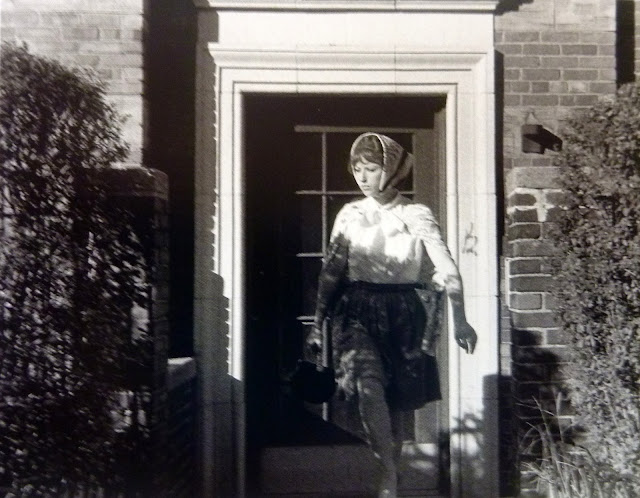Cindy Sherman at the Museum of Modern Art in New York.
A Retrospective.
We saw this exhibition in New York in April 2012 and I have finally got round to doing a post even if only on a small section of the exhibition.
The large-scale photographic mural at the entrance of the exhibition was on view for the first time in the USA. As in most of her work, she is both model and photographer, but instead of using make up or prosthetics to alter her appearance, in this instance she has transformed her face digitally, elongating her nose, narrowing her eyes, creating smaller lips. The characters she has created sport an odd mixture of costumes, in this case, an ill-fitting nude suit
and here, a feathered leotard.
Her characters are the protagonists of their worlds in which fantasy and reality merge.
In this post I will concentrate on the Untitled Film Stills and hopefully other posts will follow....
Untitled Film Stills, 70 black and white photographs which are an exploration of female roles inspired by 1950s and 1960s Hollywood, B movies and European art house films. To create her photographs Sherman assumes the roles of both photographer and model. She uses wigs, costumes, makeup, prostheses and props to alter her appearance to create a myriad of characters. Her characters resonate with the cultural images we carry around in our heads, deeply embedded cliches of women in our culture: femme fatale, ingenue, career girl, housewife and so on. They are an exploration of female identity and stereotypes in our common culture. In them the artist is invariably masked, disguised. In this deconstruction of the supposed innocence of the images of women projected by the media, the artist and role appear to have merged.
By always being the object of representation, rather than the subject, women have been rendered invisible in our culture, having no voice. This invisibility of women within the culture is one of the reasons why femininity is frequently associated with masquerade, with false representation. In embracing masquerade as the main focus of her art, Sherman is acting out this notion of femininity as masquerade, as representation of male desire: each of her characters has no voice outside this representation. The artist, in the process of posing as an embodied object is thus criticising the visual construction of the feminine which is invariably an object for the male gaze.
By implicating the media as the false mirror which promotes alienating identifications, Sherman registers this exposure as both ethical and political. As Helene Cixoux has commented: 'one is always in representation, and when a woman is asked to take place in this representation, she is of course, asked to represent man's desire'. Shermasn has expanded on notions of the male gaze concentrating on the ideological effects of patriarchal identification.
Sherman's work is about deconstructing femininity. Her subject, feminine sexuality is always constituted in and as representation, a representation of difference. She is not particularly interested in what representations say about women but rather, she investigates what representation does to women, for example, the way it invariably positions women as objects of the male gaze.
Like many of the postmodernist women artists during the 'culture wars' of the 1980s, Sherman adopted photography as the medium for her art.
A lot of the situations that Sherman has set up are suggesting some imminent danger lurking just beyond the frame.
Sources:
Craig Owens: The Discourse of Others: Feminists and Postmodernism
Eva Respini: Will the Real CIndy Sherman Please Stand Up.
































No comments:
Post a Comment